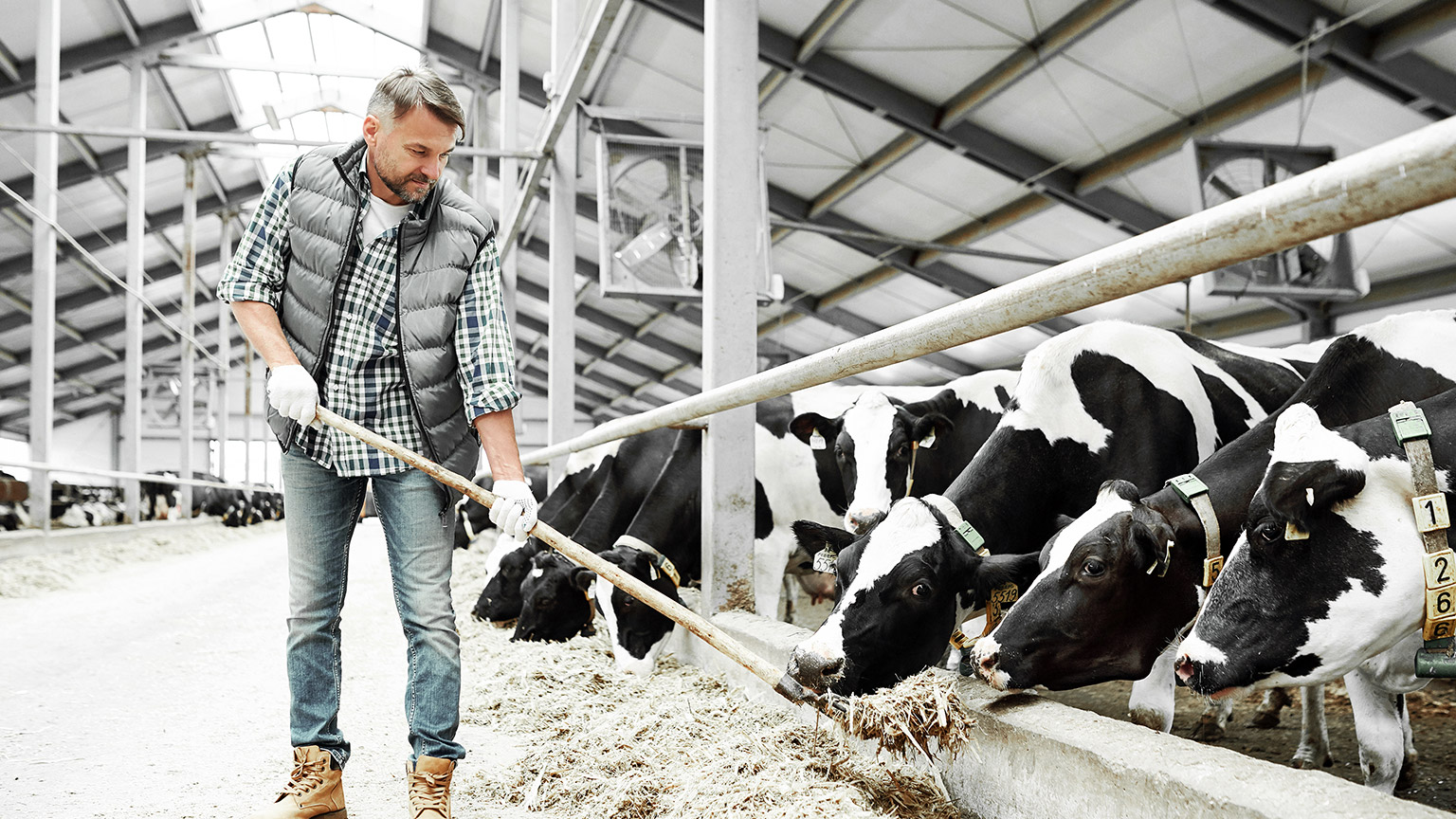Routine tasks carried out in an animal care facility
As a receptionist/or animal carer working in the reception area, you must carry out any routine tasks to assist with the animal during the appointment or booking. This could include:
- Collecting admission and discharge information
- Documenting items to be kept with animal
- Moving animals to housing or handling area
- Handing animal over to other staff or returning to the client
- Fitting collars, head collars, leads and/or Clothing
- Measuring size for clothing or other items
- Weighing an animal
- TPR – (Temperature, Pulse/Heart Rate, Respiratory Rate)
- Restraining the animal to carry out an examination, take blood or give injections
- Holding the animal for nail trims
Weighing an animal
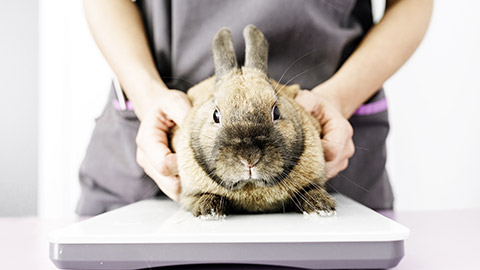
This should be done every time the animal comes into the facility and updated on their record. An animal's weight can fluctuate, and it is important to have an updated weight on record for several reasons. These include:
- Feeding requirements
- If the animal is boarding, the correct weight is required to determine the appropriate amount of food to provide for the animal.
- Medical requirements
- If an animal requires worming and flea treatment, you must know their weight to ensure you give them the correct dose. You do not want to under or over-dose the animal.
- Animal welfare
- If an animal looks skinny or notices a weight drop, you can check the record to confirm its weight at each appointment. This could help determine if there is a medical issue.
Watch
The next videos explain some of the techniques people use to weigh peculiar animals.
Moving an animal to a treatment or holding area
Appropriate restraint must be used when moving animals from one area to another. This will prevent any potential injuries or the animal from escaping. A secure lead or transport housing should be used. Even if you are holding an animal in your arms, you should still have a lead secured.
Handing an animal over to a client or another staff member
It is important that you communicate with clients and staff members. If you are handing over to another staff member at the end of your shift, you should always give them details about the animal and a rundown on the reason for their stay at the facility.
When you are handing an animal back to a client, you should always make sure you communicate any important information.
When carrying out any of these tasks, it is important that you follow the facility's instructions and the clinic's policies and procedures for handling animals.
If you have any doubts about handling an animal, make sure that you ask someone. It is important that you handle the animals with care and confidence, as the animals will pick up on any stress or anxiety that you have and can react negatively to these feelings. Animals are very perceptive, and if they feel in any way that you are not confident, they could act out, giving problems or even attempting to escape for restraint.
Watch
The next video is funny clips of dogs getting their shots and reactions. However, the video also demonstrates the importance of handling animals, teamwork, and helping animals.
Identifying Animals Correctly
In an animal care facility, accurately identifying animals and assisting with care tasks as directed by a supervisor is essential for ensuring the proper health, safety, and welfare of the animals. Here's how this can be approached:
1. Animal Identification
- Use Identification Tags or Microchips: Each animal in the facility should have a unique identifier, such as a tag, collar, or microchip, which includes their name, species, breed, age, and any medical conditions.
- Physical Characteristics: Learn to identify animals based on specific physical features like coat colour, patterns, size, ear shape, or distinguishing marks. For example, knowing the difference between breeds or species can prevent errors in care.
- Behavioural Traits: Some animals exhibit unique behaviours or personalities. Recognizing these traits (such as a shy dog versus an energetic one) can help in identification and handling.
2. Assisting with Animal Care Tasks
- Follow Supervisor’s Instructions: Carefully listen to and follow any specific instructions from the supervisor related to feeding, grooming, or administering medication.
- Feeding and Nutrition: Accurately provide the correct type and amount of food as instructed, keeping in mind dietary needs based on the animal’s species, age, or health condition.
- Grooming and Hygiene: Assist with grooming tasks such as bathing, brushing, nail trimming, and cleaning enclosures, ensuring that the animals are comfortable and safe.
- Exercise and Enrichment: Help with exercising animals by walking dogs, providing toys for play, and monitoring their well-being during these activities.
- Health Monitoring: Assist in checking for any signs of illness, injury, or behavioural changes and report them to the supervisor promptly. This may include observing eating habits, bowel movements, and overall demeanour.
- Cleaning and Sanitation: Help with the regular cleaning of enclosures, litter boxes, food bowls, and other equipment to maintain a clean, hygienic environment.
Importance of Following Supervisor's Directions:
- Ensures consistency in the care and treatment of animals.
- Minimizes the risk of errors or accidents, such as giving the wrong medication or feeding the wrong diet.
- Promotes effective teamwork, allowing the facility to run smoothly and provide the highest standard of care for the animals.
- In an animal care facility, it’s vital to be diligent, observant, and precise when identifying animals and completing care tasks to ensure the safety and well-being of all animals under your supervision.
Effective restraint is one of those aspects of animal handling that we simultaneously take for granted but also wish we could do better. Restraint techniques are passed on in an almost cultural fashion with little thought given to their logic and effectiveness. Historically, animals were restrained by physically overpowering them. This often resulted in injury to the animal or involved personal injury to the handler. Often, the restraint attempt fails, preventing the successful completion of the intended procedure.
Animal restraints may include:
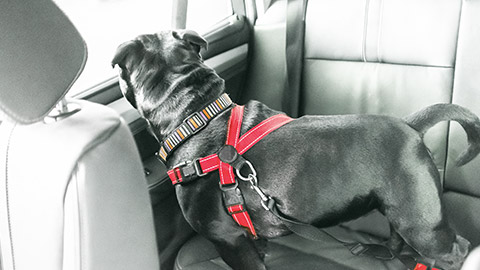
- Muzzles, collars, halters and head collars
- Rearing bits, twitch or hobbles (used on horses)
- Leads
- Holding cages
- Physical holds using hands, gloves
- Equipment (e.g., Towels or bags)
Important
This unit excludes chemical restraints.
Good restraint is about empathy, finesse, and technique

Good restraint has little to do with strength. Choosing techniques that build on natural behavioural responses results in a greater likelihood of success. This approach also encourages increased empathy and awareness of the animal as an emotional and sentient being. Safety and success are much more likely when you strive to reduce actions that the animal may view as threatening or aggressive. Adversarial handling typically increases the probability of the animal becoming aggressive or attempting to escape.
A number of factors are involved in triggering aggression and/or escape responses in animals. In laboratory settings, restraint stress has long been used as a way to study acute and chronic stress responses in animals.
In an animal care setting, the most common actions or interactions that prompt aggressive responses include fear, pain, and excessive physical restraint. Most animals show fear/defensive aggression because they find some aspect of the process threatening. This may be the environment, the personnel, the equipment, the procedure, the restraint technique used or any combination of these. The determination as to whether something is aversive or painful to an animal is based on the animal's response, not on the opinion of the staff or veterinarian.
Often, in the process of trying to be friendly to an animal, we portray body signals that actually mean the opposite. The way the average person greets a dog is a perfect example. Most people approach dogs from the front, lean over, and extend their hands to allow the dog to sniff it or to try to pet the dog. Several elements in this approach directly threaten the dog: the direct, frontal approach, making eye contact, leaning over, and reaching out over the dog's head. These are intensified if they are done in a quick, tense or agitated manner. 2
Basic reactions
Animals have 5 basic reactions to stress or threat – the five "F's":
- Fight
- Flight
- Freeze
- Faint
- Fidget (or fooling around)
Watch
The next animation is explaining the 5 F's.
The latter is an often-overlooked sign of stress. Staff members frequently assume animals that are obnoxious and hyper in the room are just plain stupid or untrained, but this is a simplistic outlook considering the situation the animal is in.
Keep open-minded that the animal's hyperactivity might actually be a stress reaction. Punishing these animals usually raises their stress level and exacerbates their behaviour.3
Professionalism and safety in animal handling and restraint
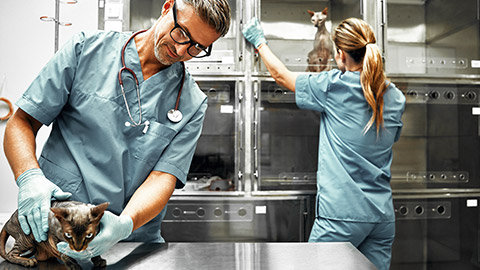
When clients and their pets come into your facility, there will be times that you will have to assist with restraining and handling animals: it is important to remember that:
- The owners will be watching you to learn how to properly handle animals
- Being professional means being SAFE and HUMANE
- Good animal handling skills prevent staff from being injured
- Good animal handling skills reduce stress for the animal
Examples of safe animal handling:
It is important that you:
- Be aware of the stressors for animals in the environment
- An animal care facility is extremely chaotic for any animal. There are an incredible number of smells and other stimuli, and animals are likely to be confused and distressed
- Many animals have lived entirely outdoors and have not been handled or examined before. They may not have any experience on a leash and may panic in response
- Even the most social animal may exhibit aggression toward other animals, particularly in a strange environment and may redirect that behaviour to nearby people when over-stimulated
- Never put your face directly into the face of a dog or cat
- Do not move in behind or crowd around a dog
- Concentrate on the animal you are handling without being distracted by other activities
- NEVER sit on the floor while handling/examining a dog. If the animal becomes aggressive or aroused, you will be unable to move away or protect yourself and risk serious facial bites
- Always be prepared to protect yourself or move away quickly in the event an animal becomes aggressive unexpectedly
Safe and effective animal handling requires a thorough understanding of the normal behaviour and responses of each species. Below is some general information on animal behaviour and handling techniques.
There is no substitute, however, for careful observation and experience.
If there is any doubt about the temperament of an animal - ASK FOR ASSISTANCE. 4
Trigger Warning
There are no extra points for being a 'hero'. The safety of staff and other animals is most important!
Communication
Any animal exhibiting potentially aggressive behaviour should have a “WATCH” sign or “CAUTION’ posted to alert other staff members who may be handling the animal. Specific alerts or recommendations should be written on the sign and in the animal’s record to provide staff with as much information as possible in relation to handling the animal.
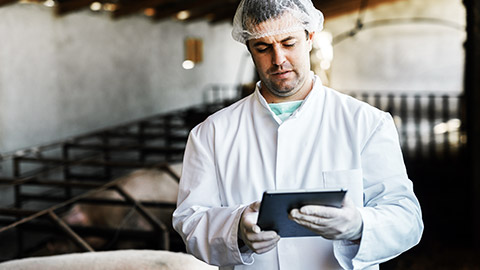
Restraint or control
The most important thing to keep in mind when handling any kind of animal is
The least restraint is often the best restraint
This does not mean that you lose control. More importantly, you use as little restraint as necessary while maintaining control of the situation. Every animal and every situation is different, so there are no hard and fast rules as to what method works best in which situation.
Before you attempt to restrain any animal, you should take a few minutes so as to allow the animal to become comfortable with you and the facility. It will help if you:
- Crouch down so that you are on their level. Do not sit on the ground, as you will be unable to move away or protect yourself if necessary
- Avoid crouching over the animal, as some can take this as a form of aggression
- Avoid direct eye contact but maintain safe visual contact with the animal
- Talk in soothing tones. Avoid high-pitched, excited talk
- Try patting your leg or the ground, motioning the animal towards you
Types of restraint
Verbal restraint:
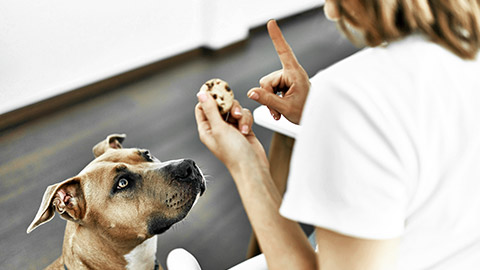
Many dogs know some commands or can at least recognise authority, even if the command is unfamiliar.
Commands such as SIT, STAY, COME, DOWN, NO or even HEEL may be useful tools to encourage a dog to cooperate. Also, soft, quiet words can calm a frightened animal. Yelling or screaming should never be used, as it can cause the animal to become more fearful or aggressive.5
Physical restraint: tools and equipment
Leash:
The most common tool used to handle animals is the leash. Placed around a dog's neck, it normally controls even the largest dog. In the event a dog refuses to cooperate with a leash, it might be advisable (if possible) to carry him. Some dogs have never seen a leash and will freeze up to the sensation around a sensitive area like the neck.
- Remember that leashes should not be abused; never drag or strangle an animal with a leash. It is very important that you stay calm, take time to pause, let the dog calm down, and try again after reassuring her. Sometimes, a quick tug on the leash will encourage a fearful dog to walk. If the dog refuses to walk, apply a muzzle (if necessary) and carry them (if possible).
- It is VERY IMPORTANT that you remember that every animal being transported or handled in the facility must ALWAYS wear a slip-lead. This includes puppies, cats and sedated animals. It is far too easy for a frightened animal to get loose and escape. If an animal is coming into the hospital or day stay, the animal that comes into your clinic with their owner, who is on a collar and leash, should be transferred to a slip lead and the leash returned to the client so that it is not lost during the animal’s stay.
Your hand:
- Your hands are a very effective form of restraint; your hands are sensitive to the amount of pressure that you can exert on the animal so that you can quickly modify your grip on the situation. Hands can also be used to gently stroke a dog or to firmly grasp a struggling cat. Although hands can be very versatile, they are also the most vulnerable to injury, so remember to take care when you are handling animals. Recognising when they would not be effective is also very important.
Towels:
- A towel or blanket is a very useful tool for restraining cats and small dogs. A towel can be used to decrease an animal’s movement as well as reduce their arousal by covering the head and body and can help protect from their sharp claws.
Nets:
- The net is the primary tool used to handle fractious cats or wildlife. It allows for the safe handling and transfer of even the most aggressive small mammal. Effective use of the net requires some training and practice. If you need to handle a feral or fractious cat, ask for assistance from a staff member.7
EZ-Nabbers:
- EZ Nabbers Ensure the safety for animal handlers, providing a safe and humane way to capture animals, aseptic intramuscular injections of tranquillizers, anaesthetics and vaccines can be given through the net. Pets can be transferred from one cage to another without injury or stress to the animal or the clinic's staff. Pets can be removed from and/or placed in pet carriers. When the net becomes soiled, leave it on the frame and wash it in the tub with soap and water; use a disinfectant if needed. Abscesses and wounds can be flushed, and the pet can be bathed in the net. 8
Muzzles:
- Muzzles are used when dealing with snappy or potentially aggressive dogs. There are a number of types of these, including nylon muzzles and plastic baskets available. A leash or strip of rolled gauze can be used as a temporary muzzle. Because dogs often try to remove a muzzle, it is important that the muzzle is placed on the animal securely.
- A weak or poorly made muzzle may lead to a false sense of security and the possibility of being bitten. Even with a securely placed muzzle, appropriate handling must be used to prevent injury from an animal who resists.
- Muzzles designed for cats extend up to cover the eyes, reducing visual stimulation. For some cats, these can be very useful for calming the animal and helping to protect the handler from injury,
Drugs:
- When an animal is aggressive or very stressed, it can be handled safely for procedures, sedation, and/or general anaesthesia, or treatment is allowed. It is important that if you are unable to handle an animal, notify a staff member to determine whether sedation is appropriate.
- When receiving an animal for surgery who exhibits difficult or aggressive behaviour, consult the Anaesthesia Lead prior to kennelling the animal, as we may opt to administer a pre-anaesthetic sedative immediately and expedite the surgery process to minimize the animal’s time in the clinic.
The place where the correct use of restraint is the most critical is when two people are handling the animal.
This could be to perform a physical exam, administer an anaesthetic or give medications.
The "holder" is the person whose job it is to restrain the animal in such a way that the procedure can be accomplished with the least amount of stress to both handlers and animals. The specific amount of restraint used to control the animal is the key to safety for the handlers and comfort for the animal.
Too much restraint can cause the animal to fight back, too little restraint can result in the handler or others being injured or in the animal escaping9
Case Study
Extract from Happy Paws Animal Care Facility Policy and Procedure- Fitting a dog collar
- Choose the Right Collar
- Type: Select a collar appropriate for the dog’s size, breed, and temperament. For instance, flat collars are commonly used for daily wear, while martingale collars can prevent escape for dogs with narrower heads.
- Material: Ensure the collar is made of comfortable, non-irritating material such as nylon or leather, avoiding anything too rigid or abrasive.
- Size: Measure the dog's neck before purchasing the collar to ensure it will fit correctly without being too tight or too loose.
- Calm the Dog
- Make sure the dog is in a calm and relaxed state before fitting the collar. Use a soft voice, gentle petting, and treats to reassure them.
- If the dog is anxious, introduce the collar slowly, allowing them to sniff and inspect it to create a positive association.
- Adjust the Collar to the Correct Size
- Adjust the collar so it will fit snugly but comfortably around the dog’s neck. A good rule of thumb is to leave enough room to fit two fingers between the collar and the dog’s neck. This ensures the collar isn’t too tight, restricting breathing or movement, and isn’t too loose, allowing the dog to slip out.
- Avoid overtightening, as this can cause discomfort or injury.
- Slowly Fit the Collar
- Gently slip the collar over the dog's head or wrap it around their neck if it’s an open-style collar.
- Be slow and steady in your movements to avoid startling the dog, making the experience as stress-free as possible.
- Speak in a reassuring tone to keep the dog calm.
- Check the Fit and Comfort
- Once the collar is on, check it by ensuring you can still fit two fingers between the collar and the dog’s neck.
- The collar should sit high on the neck, not sliding down too far or pressing too low on the trachea.
- Make sure it’s not pinching the skin or fur, which could cause discomfort or irritation.
- Observe the Dog’s Behavior
- Watch the dog for signs of discomfort, such as excessive scratching, shaking, or whining. If the dog seems uncomfortable, recheck the fit and adjust as needed.
- If the dog continues to resist, consider removing the collar and reintroducing it slowly, using treats and praise to make it a positive experience.
- Introduce Positive Reinforcement
- Reward the dog with treats or praise for staying calm during the process. This will help them associate the collar with positive outcomes.
- Gradually increase the time they wear the collar, starting with shorter periods if the dog is not used to wearing one.
- Regularly Check the Collar’s Fit
- Especially with growing puppies, check the collar regularly to ensure it’s still fitting comfortably. Adjust as necessary to accommodate growth or changes in weight.
Additional Tips:
- Avoid choke or prong collars unless specifically recommended by a professional trainer, as these can cause injury if used improperly.
- For dogs with sensitive skin or allergies, choose hypoallergenic materials or padded collars.
Extract from Happy Paws Animal Care Facility Policy and Procedure- Fitting a dog leash
- Choose the Right Leash
- Length: Select a leash that is appropriate for the dog's size and behaviour. For most dogs, a leash of 4 to 6 feet works well for regular walks. For larger or stronger dogs, a shorter leash may provide more control.
- Material: Choose a durable but comfortable leash made of nylon, leather, or rope. Avoid chains or overly heavy leashes that could be uncomfortable for the dog.
- Clip Type: Ensure the leash has a secure, easy-to-use clip that attaches safely to the dog's collar or harness without pinching or pulling at their fur
- Ensure the Dog is Wearing a Properly Fitted Collar or Harness
- Before attaching the leash, ensure the collar or harness is fitted snugly but comfortably, allowing two fingers to fit between the collar and the dog’s neck.
- Harnesses can be a better option for some dogs, especially for those who pull, as they distribute pressure more evenly across the body rather than the neck.
- Calm the Dog Before Attaching the Leash
- If the dog is excited or anxious, wait for them to calm down before attempting to attach the leash. You can offer treats or speak calmly to reassure them.
- Use positive reinforcement to make the experience pleasant for the dog. Let the dog associate the leash with fun activities like going for a walk, which can reduce anxiety.
- Attach the Leash to the Collar or Harness
- Stand or kneel beside the dog, holding the leash in one hand. Gently attach the clip to the D-ring on the dog’s collar or harness.
- Ensure a smooth attachment: Make sure the clip is securely fastened but doesn’t pinch the skin or catch any fur. Check the fit to make sure the leash isn’t twisted or tangled.
- If using a harness, attach the leash to the designated leash attachment point, typically located on the back or chest of the harness.
- Check for Comfort and Security
- Once the leash is attached, check that the dog is comfortable and not pulling against the collar or harness. The leash should have some slack but be manageable to maintain control.
- If using a retractable leash, lock it at a short length to start, giving the dog more space once you have established control.
- Use Positive Reinforcement
- Reward the dog with praise or treats for staying calm while the leash is being attached. This will help the dog associate the leash with positive experiences.
- Reinforce calm behaviour before starting the walk to set a positive tone for the outing.
- Walk with Controlled Movements
- As you begin walking with the dog, hold the leash with a relaxed grip, but be ready to guide or redirect the dog if necessary.
- f the dog pulls, stop walking and wait for them to calm down before continuing, or consider using a no-pull harness for better control.
- Avoid Sudden Movements
- Do not jerk the leash or pull the dog suddenly, as this can cause stress or discomfort. Instead, gently guide the dog in the desired direction using positive cues and rewards.
Additional Tips:
- Use a harness for small breeds or brachycephalic (flat-faced) dogs to avoid putting pressure on their necks.
- Inspect the leash regularly for wear and tear to ensure it remains safe and functional.
Watch
The next couple of videos explain the different animal handling techniques used on different types of animals.
Case Study
1. Administering Medication to a Dog Scenario
A medium-sized dog, Bella, needs oral medication, but she is nervous and tries to avoid taking the pills.
Restraint Method:
- Two-person hold with a towel wrap (if needed).
- Have one person gently kneel beside the dog, keeping calm and speaking softly to reassure her. The person should hold Bella’s body close using their arms while ensuring not to apply excessive pressure.
- The second person can carefully open the dog's mouth and administer the medication.
- If Bella is very nervous, wrapping her gently in a towel to limit excessive movement can help, as can taking care not to cover her face or restrict breathing.
2. Examining a Cat's Ears for Mites
Scenario:
- A cat named Whiskers needs her ears checked, but she tends to scratch and wiggle during exams.
Restraint Method:
- Towel restraint (burrito wrap).
- Place Whiskers on a non-slip surface, then gently wrap her body in a towel, exposing her head. This technique provides a sense of security and prevents scratching without causing distress.
- Hold her firmly but gently, ensuring she can still breathe comfortably. One hand can steady her head while another checks the ears.
3. Trimming the Nails of a Rabbit
Scenario:
- A rabbit named Thumper needs his nails trimmed but is frightened and prone to quick, sudden movements.
Restraint Method:
- Bunny burrito wraps with support for back and legs.
- Wrap the Thumper gently in a towel, ensuring his back is always supported to prevent spinal injury. The front paws should be left exposed for trimming.
- Keep the towel snug but tight, and speak softly to the rabbit to reduce stress. Have a second person assist in trimming the exposed paw.
4. Handling a Nervous Bird for a Health Check
Scenario:
- A small parrot named Kiwi requires a routine health check, but he gets very stressed when handled.
Restraint Method:
- Two-handed restraint (using finger holds).
- Use a small towel or gloves to avoid injury from the bird’s beak or talons. Hold Kiwi firmly but gently, placing one hand around his neck and the other supporting his body and feet.
- Ensure not to squeeze and keep his wings folded against his body. Speak calmly to reduce stress during the procedure.
5. Restraining a Goat for Hoof Trimming
Scenario:
- A goat named Billy needs his hooves trimmed, but he is restless and keeps pulling away.
Restraint Method:
- Head hold with lateral restraint.
- Stand beside Billy and gently hold his head, using one arm placed around his neck while holding his body steady against your leg with your other arm and leg.
- If necessary, another person can hold Billy’s legs or use a goat stand to further secure him. Always be mindful of the goat’s comfort, ensuring it is not in pain or overly stressed.

Updating clients
Throughout the day, you will interact with clients and give them updates on the animals in the facility. You might update a client if:
- An animal is boarding
- This could be a simple photo sent to the client, a text message or a phone call to let them know their animal is okay.
- An animal is ready to go home after a service has been provided
- You may need to call an owner to let them know that their animal is ready to be picked up.
- An animal is at the clinic seeking medical treatment
- Providing them with information face to face, via phone or email about medications administered, progress of animal, any complications and any health concerns.
- Addressing owner-specific concerns
- If the owner had specific concerns prior to or during the animal's stay, address how these were managed and any outcomes observed.
- Upcoming Care Recommendations
- Provide recommendations for ongoing care, including any upcoming vaccinations, treatments, or follow-up appointments. Offer advice on how to continue supporting the animal’s health and well-being at home, such as dietary adjustments, continued training, or enrichment activities.
Reporting on animal welfare
If you believe an animal requires veterinary attention or you have concerns about an animal, you should report this directly to your supervisor.
- Overview of Animal's Condition
- Animal Identification: Provide the animal's name, species, breed, age, and any identification numbers or tags.
- General Health Status: Briefly describe the animal's overall health, noting any changes since the last report.
- Recent Health Assessment
- Routine Checks: Summarize the results of any recent health assessments, including weight, vital signs, and any notable physical observations.
- Medical Issues: Highlight any health problems identified, such as infections, injuries, or symptoms of illness.
- Medical Treatments and Procedures
- Medications Administered: List any medications given, including dosages and administration times. Note any side effects or reactions observed.
- Veterinary Visits: Mention any recent veterinary consultations or procedures, along with the outcomes or recommendations provided by the vet.
- Preventative Care: Update on vaccinations, deworming, flea/tick treatments, or any other preventative measures taken.
- Behavioural Observation
- Behavioural Changes: Report any changes in the animal's behaviour, such as increased anxiety, aggression, or signs of depression.
- Interaction with Staff and Other Animals: Describe how the animal interacts with staff members and other animals. Note any issues with socialization or signs of distress.
- Activity Levels: Provide information on the animal’s energy levels and engagement in physical activities.
- Diet and Nutrition
- Feeding Habits: Outline the animal’s current diet and any changes in eating habits. Note any issues such as loss of appetite or difficulty eating.
- Nutritional Adjustments: If there have been any changes to the diet (e.g., due to weight loss or allergies), explain why these changes were made and the animal's response.
- Living Environment
- Housing Conditions: Describe the cleanliness and suitability of the animal's living environment, including bedding, access to fresh water, and temperature control.
- Environmental Enrichment: Report on providing enrichment activities, such as toys, social interaction, or exercise, and the animal’s engagement with these.
- Quarantine and Isolation (if applicable)
- Quarantine Status: If the animal is in quarantine, report on the reasons for isolation, the duration, and any observations during this period.
- Health Monitoring: Detail the monitoring procedures in place for quarantined animals and any signs of improvement or deterioration.
- Progress and Milestones
- Improvements Noted: Highlight any areas where the animal has shown improvements, such as recovery from illness or injury, weight gain, or behavioural progress.
- Ongoing Concerns: Identify any ongoing issues that require further attention or monitoring.
- Recommendations for further actions
- Additional Care Needed: Suggest any additional treatments, dietary changes, or environmental adjustments that may benefit the animal.
- Follow-Up Actions: Recommend follow-up actions, such as scheduling a veterinary visit, increasing monitoring frequency, or adjusting care routines.
- Summary and Next Steps
- Overall Summary: Briefly summarise the animal’s current welfare status and any key concerns that need addressing.
- Next Steps: Outline the next steps that should be taken to ensure the continued well-being of the animal.
Example of a Report Template to your supervisor
| Animal/ Breed | Canine, Golden Retriever |
|---|---|
| Animal Name | Bella |
| Age | 5 Years |
| Date | |
| Prepared by |
| Overview of Animal's Condition | Bella's general health is stable, though she has shown signs of mild discomfort in her left hind leg during walks. |
|---|---|
| Recent Health Assessment | Routine checks indicate that Bella’s weight remains stable at 28 kg. However, she displayed slight tenderness when her hind leg was palpated. |
| Medical Treatment/ Procedure | Bella is currently on anti-inflammatory medication for her leg, which was prescribed after a veterinary examination. No adverse reactions have been observed. |
| Behavioural Observation | Bella’s activity levels have decreased slightly, likely due to her leg discomfort. She remains friendly with staff and other dogs but is less inclined to engage in play. |
| Diet and Nutrition | Bella’s appetite is normal, and she is on her regular diet. No changes in feeding habits have been noted. |
| Living Environment | Her kennel is clean and comfortable, with adequate bedding and fresh water. Environmental enrichment activities are provided daily. |
| Quarantine & Isolation | N/A |
| Progress and Milestones | Bella’s leg discomfort has shown minor improvement since the start of her medication. Continued observation is recommended. |
| Recommendations for further action |
|
| Summary/ Next Steps | Bella’s overall condition is stable, but her leg injury requires continued monitoring. I recommend maintaining her current care plan and reviewing her condition in a week. |
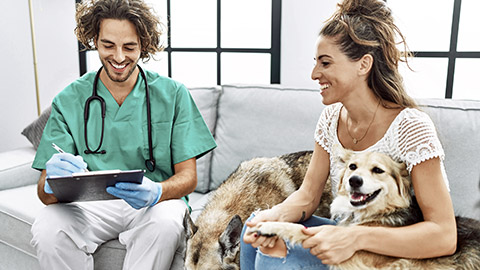
It is very important that your clinic's policies and procedures document any interaction with the clients and their pets.
Most documentation is written in the client’s files, which are stored on a computer system such as a vet link.
Interaction with clients may include:
- Inquiries about products and services:
- Telephone or face-to-face
- Email or internet
- Collecting payments
- Advising of problems with payments
- Dealing with initial complaints about products, services or staff
- Dealing with distressed clients
- Instructions from clients about products and services required
- Providing information within the limits of business policy and personal responsibility
- Referring clients to senior staff
- Reporting on animal welfare or progress
- Relaying potentially upsetting news
Some interaction with clients and their pets can be in the form of a written proformas, such as:
- Boarding consent
- Grooming consent
- Anaesthesia Record
- Hospital treatment sheet
- New clients form
- Blood sample forms
- Admission forms
- Animal histories
- Vaccination records
These forms can be transferred to the computer system. Information must always be documented following the clinic's policies and procedures.
